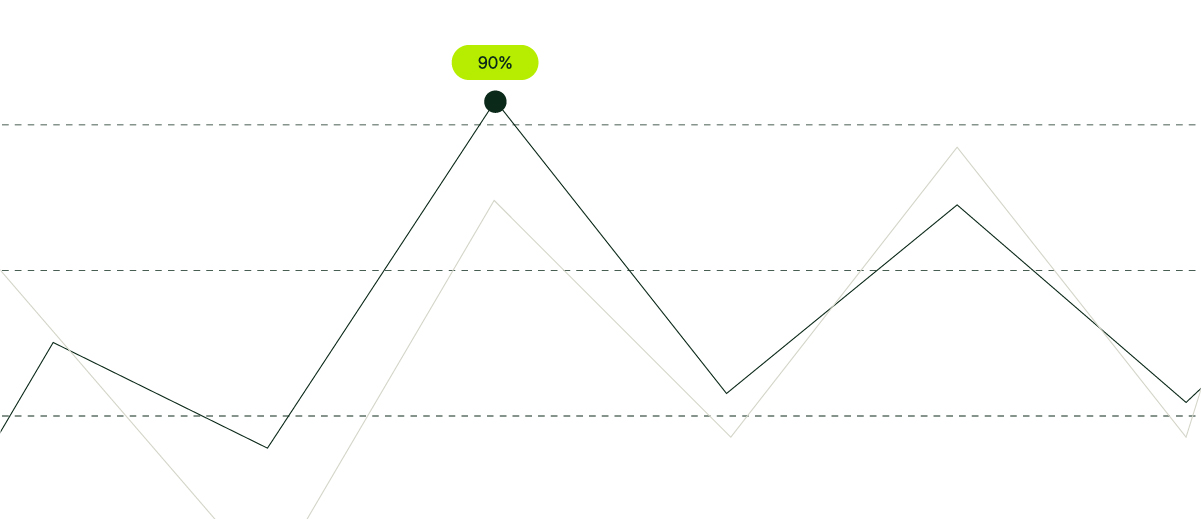Welcome to the IOC, the only intergovernmental organization in the world to bring together all the stakeholders involved in the production and consumption of olive oil and table olives.
Here you’ll find an overview of the latest sector statistics, including an update on olive oil prices, trends in international trade in olive oil and table olives, and producer prices for olive oil.
Follow us and visit our website to be up to date with the latest data! Don’t hesitate to send us an e-mail if you have any questions (iooc@internationaloliveoil.org).
Olive Oil Production
Olive oil production has tripled over the last 60 years, reaching 2,760,000t in the last crop year (2022/23). Provisional figures for the 2023/24 crop year show a 7% fall in production, to 2,564,000 t, while the estimate for the 2024/25 crop year shows production reaching 3,375,500 t (+32%).

Graph 1 – Evolution of olive oil production. Annual rates of change based on 1958/59.
-
Olive oil – Provisional crop year 2023/24
Although the figures are still provisional, world production for the 2023/24 crop year is estimated to have reached 2,564,000 t, down 7% (-196,000 t) on the previous year; consumption, 2,780,000 t (-3%); and imports, 1,015,000 r.

Table 1 – Olive oil production.
IOC member countries are estimated to have produced a total of 2,404,000 tonnes, or 94% of the world total for the 2023/24 crop year.
The group of European countries is estimated to have produced 1,531,500 t, an increase of 10%. Several countries saw their production increase: +28% in Spain (854,000 t), +36% in Italy (328,500 t), +28% in Portugal (160,900 t). By contrast, production in Greece is said to have fallen by 49% (175,000 t).
Production by other IOC member countries came to a total of 872,500 t. Türkiye saw its production (215,000 t) fall very sharply (-52%) compared to the previous crop year.
Consumption is estimated to have reached 1,925,000 t in IOC member countries and 855,000 t in non-member countries (-8%).
-
Olive oil – Estimates for the 2024/25 crop year
According to official data from countries and estimates from the IOC Executive Secretariat, world production for the 2024/25 crop year could reach 3,375,500 tonnes, an increase of 32% on the previous year. Imports and exports are expected to exceed 1.2 million tonnes.
IOC member countries as a whole are forecast to produce 3,193,000 t, or 95% of the world total in 2024/25, an increase of 33% on the previous crop year. EU producing countries as a whole are forecasting production of 1,973,000 t, an increase of 29%. Other IOC member countries should produce a total of 1,220,000 t (+ 40%).
World consumption could reach 3,064,500 t, an increase of 10% on the previous year.

Graph 2 – Trends in olive oil production.
Table Olive Production
-
Table olives – Provisional crop year 2023/24 and estimated 2024/25
World production for the provisional crop year 2023/24 is estimated at 2,828,500 t, down 12% on the previous year. Among IOC member countries, Türkiye’s production is down significantly (-33%), while Egypt’s share of world table olive production is growing (23%), with an increase of 8% during the 2023/24 crop year.

Graph 3 – Growth in table olive production (2023/24-2022/23) and share of production (2023/24).
Production for the 2024/25 crop year is estimated to increase by 12% to 3,178,000 t.

Table 2 – Table olive production.

Graph 4 – Growth in table olive production.
Prices
The latest figures for the last week of November put producer prices for extra virgin olive oil at €530 per 100kg in Jaén (Spain), 28.9% down on the same week in the previous crop year, and €915 per 100kg in Bari (Italy), an increase of 1.7%.

Graph 5: Trend in monthly producer prices for extra virgin olive oil.
Exports and Imports
The unit value of extra-Community olive oil exports from the European Union was €881 per 100 kg in September of the 2023/2024 crop year, (+19.6% compared to the same period of the previous year or -3.7% compared to the previous month). The figure for extra virgin olive oil was €930 per 100 kg.

Graph 6: Monthly evolution of the unit value (FOB) and volume of extra virgin olive oil exports from the European Union. Volume in tonnes. Value in euros.
The unit value index for exports fell for the sixth consecutive month compared with the same month last year. In September, it was 3.4% lower than in August.

Graph 7 – Monthly evolution of the unit value index of extra-EU olive oil exports. Rate of change (m/m-12) (%).
Imports of olive oil by the main markets (see table below) rose by 0.6% between October 2023 and September 2024 compared with the same period of the 2022/2023 crop year.
 Table 6 – Olive oil imports from some of the main markets. Volume in tonnes.
Table 6 – Olive oil imports from some of the main markets. Volume in tonnes.
Consumer Prices
In October 2024, the Harmonised Index of Consumer Prices (HICP) for olive oil in the EU was 14.4% higher than in the same month of the previous year and 0.6% lower than in the previous month, continuing the downward trend that began in April 2024.

Graph 8 -Changes in the HICP for olive oil in the EU-27. Rate of change (m/m-12) (%).
By country, the biggest increases were recorded in Bulgaria and Estonia.

Graph 9 – HICP for olive oil by country in the EU-27. Rate of change (m/m-12) (%).

Graph 10 – HICP for olive oil by country in the EU-27. Rate of change (m/m-12) (%).
* The figures presented in this document are subject to change or correction without notice.
Click on these links to read more about olive sector prices, exports, and other relevant information.









